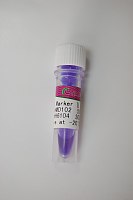Bisulphite Sequencing of Plant Genomic DNA
互联网
629
DNA methylation is a prominent epigenetic mark and extensively found within plant genomes. It has two major roles– first, defending the genome against invasive DNA and second, regulation of gene expression. Since the first report of 5-methylcytosine found in wheat germ, many improvements in detection of methylated cytosine residues have been made and genome-wide methylation maps for Arabidopsis thaliana are now available. The development of fast, reproducible, and single-base pair resolving detection methods for DNA methylation at defined loci advanced our understanding of the establishment and maintenance of DNA methylation patterns. Bisulphite conversion of unmethylated cytosine residues followed by detection methods such as sequencing of distinct loci has become accepted as the gold standard for detecting 5-methylcytosines. Treatment of single-stranded DNA with bisulphite under acidic conditions leads to the conversion of cytosine residues to uracil whereas 5-methylcytosine is less sensitive and remains unchanged. Here, a detailed protocol for bisulphite conversion, primer design, and optimization of PCR conditions is given. Specific requirements for plant DNA are discussed.







